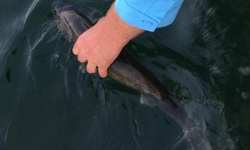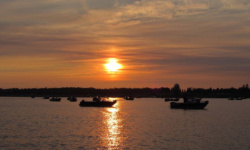by: Tim Lesmeister
Kayak fishing has exploded in popularity since I first bought one in 2007.
I’ve owned four models of kayaks and many different configurations when it comes to sonar styles, rod-holder positioning, and extras like livewells, nets, and even wading shoes. Many of today’s serious kayak anglers use watercraft designed just for fishing, but I find them too heavy for my needs. The model I currently use is a Hobie Outback, which is plenty for my fishing needs. And this year, I’m modifying my kayak strategy and going even smaller.
The Hobie Sport that I will soon acquire is five inches shy of 10 feet long and barely over 60 pounds. It has a capacity of 225 pounds, which is why I’ve worked to slip down a belt size. By the time I hit the open water, I’ll be in prime shape for this smaller kayak.
What’s my motivation? I want to access bodies of water that see little to no fishing pressure. I can do this with the Outback on some of the waters I fish now, but there are others where I yearn for a smaller profile.
I discovered the benefits of entering waters that received little in the way of fishing pressure when I first started kayak fishing. You might think these bodies of water are out in the middle of nowhere, but some are right in the heart of the Twin Cities.
One example of a metro lake that sees little fishing pressure is Gleason Lake, just north of Wayzata, Minn. This lake has no public access, but I enter it by rolling my kayak on the portage wheels down a quarter mile of walking trail that splits the two basins of this lake. I catch huge largemouth bass, northern pike, crappies, and sunfish there.
Not that I mind entering the wilderness. There are some lakes just outside the Boundary Waters Canoe Area Wilderness in northern Minnesota where you need no permit to fish, have marginal public access, and receive almost no fishing pressure. The walleye and smallmouth bass fishing on these lakes is phenomenal.
I have portaged my Outback into lakes in Canada where I was the only angler and caught walleyes, smallmouth bass, and huge northern pike on every cast for hours.
In Alaska, my son and I portage the Outbacks into lakes where huge rainbow trout will fight on the end of our line while we watch moose feeding in the bays. Sometimes brown bears will wander up to the shorelines to see what we’re catching.
In 2018, I’ll explore all the little lakes in the Chequamegon Forest in northern Wisconsin and hit some of the rivers down in Iowa where I might even slip the Sport into a big farm pond or two.
The tremendous fishing I have experienced in my kayaks has spoiled me. But, instead of making a move into a larger watercraft, I’m downsizing to allow easier access into small waters with a big bite.






